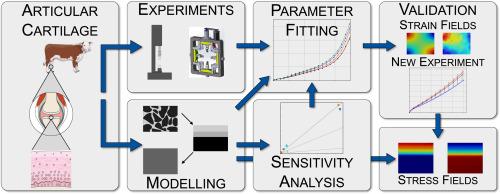Computational modeling of articular cartilage: Mechanical experiments, sensitivity analyses, parameter identification, and validation
IF 9.6
1区 医学
Q1 ENGINEERING, BIOMEDICAL
引用次数: 0
Abstract
Articular cartilage is a complex, multiphase material whose mechanical behavior is crucial for understanding joint function and diseases such as osteoarthritis. In this study we address the critical need to improve the fidelity of finite element simulations for cartilage by integrating mechanical experiments, sensitivity analyses, parameter identification, and validation to refine a well-established biphasic constitutive model for articular cartilage. Our sensitivity analyses using the Morris method identified fiber stiffness as dominant in uniaxial extension, while permeability and matrix stiffness played significant roles in confined compression. Parameter fitting for uniaxial extension achieved an excellent match with experimental force–displacement curves (), and fitting permeability parameters for confined compression achieved a similarly excellent match to stress–strain responses (). Independent validation against biaxial extension experiments demonstrated that simulated stress–strain curves fell within the experimental range. Displacement and strain fields from uniaxial extension simulations also showed good agreement with data from digital image correlation, with minor discrepancies attributed to experimental variability and boundary conditions. Our results underscore the importance of fiber reinforcement in tension and interstitial fluid pressurization in compression. We publicly release our work via the data repository of the University of Stuttgart (DaRUS, https://doi.org/10.18419/DARUS-4729). Our validated biphasic model provides a robust tool for investigating cartilage mechanics and could aid in developing improved treatments for cartilage degeneration.
Statement of Significance
Articular cartilage is an anisotropic, heterogeneous soft tissue facilitating frictionless function of joints. Its complex microstructure determines the load-bearing functionality, and varies among patients and in disease. We advance understanding of cartilage mechanics by employing a specialized, biphasic constitutive model implemented within FEBio (University of Utah) to analyze cartilage under diverse loading conditions. We conduct sensitivity analyses leveraging new experiment data from uniaxial tension and confined compression testing to establish key material parameters and assess the model’s sensitivity. Experimental data from uniaxial tension, confined compression, and biaxial tension provide additional insights into the heterogeneous mechanical behavior of this remarkable soft tissue. By combining new experiments, sensitivity analyses, and careful parameter fittings, we validated our fitted model and improved prediction fidelity.

关节软骨的计算建模:力学实验、敏感性分析、参数识别和验证。
关节软骨是一种复杂的多相材料,其力学行为对理解关节功能和骨关节炎等疾病至关重要。在这项研究中,我们解决了提高软骨有限元模拟保真度的关键需求,通过整合力学实验、敏感性分析、参数识别和验证来完善一个完善的关节软骨双相本构模型。我们使用Morris方法进行敏感性分析,发现纤维刚度在单轴拉伸中起主导作用,而渗透率和基质刚度在受限压缩中起重要作用。单轴拉伸参数拟合与试验力-位移曲线拟合良好(R2≥0.989),密闭压缩渗透率参数拟合与应力-应变响应拟合良好(R2>0.998)。通过对双轴拉伸实验的独立验证,模拟的应力-应变曲线在实验范围内。单轴拉伸模拟的位移和应变场与数字图像相关的数据也显示出良好的一致性,由于实验变化和边界条件的影响,差异较小。我们的研究结果强调了纤维增强在拉伸和压缩间质流体加压中的重要性。我们通过斯图加特大学的数据存储库(DaRUS, https://doi.org/10.18419/DARUS-4729)公开发布我们的工作。我们验证的双相模型为研究软骨力学提供了强大的工具,并有助于开发改进的软骨退变治疗方法。关节软骨是一种各向异性、异质性的软组织,促进关节的无摩擦功能。其复杂的微观结构决定了其承载功能,并因患者和疾病而异。我们通过采用FEBio(犹他大学)实施的专门的双相本构模型来分析不同载荷条件下的软骨,从而提高对软骨力学的理解。我们利用单轴拉伸和限压试验的新实验数据进行敏感性分析,以建立关键材料参数并评估模型的敏感性。单轴拉伸、受限压缩和双轴拉伸的实验数据为这种非凡的软组织的非均匀力学行为提供了额外的见解。通过结合新的实验、灵敏度分析和仔细的参数拟合,我们验证了我们的拟合模型,并提高了预测的保真度。
本文章由计算机程序翻译,如有差异,请以英文原文为准。
求助全文
约1分钟内获得全文
求助全文
来源期刊

Acta Biomaterialia
工程技术-材料科学:生物材料
CiteScore
16.80
自引率
3.10%
发文量
776
审稿时长
30 days
期刊介绍:
Acta Biomaterialia is a monthly peer-reviewed scientific journal published by Elsevier. The journal was established in January 2005. The editor-in-chief is W.R. Wagner (University of Pittsburgh). The journal covers research in biomaterials science, including the interrelationship of biomaterial structure and function from macroscale to nanoscale. Topical coverage includes biomedical and biocompatible materials.
 求助内容:
求助内容: 应助结果提醒方式:
应助结果提醒方式:


